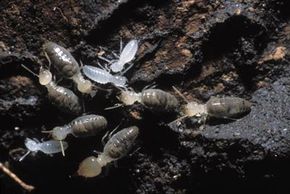Exterminating Termites
If you discover an infestation of fleas or roaches in your home, you can often take care of it with over-the-counter products. This is not the case with a termite infestation. Although some of the chemicals that kill fleas and roaches will also kill termites, applying them to a termite infestation requires special tools and training.
When an exterminator comes to your home, he will first verify that termites are the culprit. Other insects, including carpenter bees and some species of ants, can also damage wood homes. Some people may also mistake water damage for termite damage. An exterminator will use tools like long probes, heat sensors, sound sensors, infrared cameras, hammers and drills to look for termite damage.
Advertisement
If the exterminator finds conclusive signs of termites, he may use one of three treatment methods:
- Baits are wood, cardboard or other cellulose-containing products soaked in a pesticide. Termites eat the baits and carry particles back to their nests, poisoning the rest of the colony.
- Repellents discourage termites from entering a particular area. These can help keep termites from colonizing a new site in your home.
- Termaticides kill the termites. Sometimes, exterminators have to pump hundreds of gallons of termaticide into termite nests in an attempt to treat the infestation. Another tactic involves applying an insecticide around the entire perimeter of the home and at every possible termite entry point. This keeps termites from getting inside, and any that are already inside usually die of dehydration.
Fortunately, it takes years for termites to do significant damage to a home. So if you discover an infestation on your property, you have time to get estimates from several exterminators. Before making a decision, find out what kind of warranty or guarantee the exterminator offers and whether you will have to pay for further treatments if the termites reappear. It's also a good idea to contact your local cooperative extension office to learn how your state governs termite control. That way, you can make sure that the exterminator you choose is properly licensed and qualified.
Related HowStuffWorks Articles
- How Fleas Work
- How Cockroaches Work
- How Bees Work
- How Snakes Work
- How Alligators Work
- How Mosquitoes Work
- How Spiders Work
- How Sharks Work
- How Whales Work
- How Dogs Work
- How Cicadas Work
- How Bats Work
- How Evolution Works
- How Allergies Work
- How do honeybees make honey?
- How can you train honeybees to sniff for bombs
- Insect Quiz
More Great Links
- PBS: Termite Teamwork
- Dr. Don's Termite Pages
- Insecta Inspecta
- University of Toronto Urban Entomology Program
Sources
- Australian Museum. "Termits." (8/24/2007) http://www.austmus.gov.au/factsheets/termites.htm
- Dr. Don's Termite Pages http://www.drdons.net/whatr.htm
- Gold, Roger E. "Subterranean Termites." Texas Agricultural Extension Service (8/24/2007) http://insects.tamu.edu/extension/bulletins/b-6080.html
- Homeostasis in Termite Colonies (8/24/2007) http://www.esf.edu/efb/turner/termite/social%20homeostasis.htm
- Houglin, Andy. "Macrotermes bellicousus." Insecta Inspecta. (8/24/2007) http://www.insecta-inspecta.com/termites/macrotermes/index.html
- Kamble, Shripat T. "Termites." University of Nebraska: Lincoln (8/24/2007) http://www.ianrpubs.unl.edu/epublic/pages/publicationD.jsp?publicationId=338
- Koehler, P.G. and C.L. Tucker." Subterranean Termites." University of Florida. (8/24/2007) http://edis.ifas.ufl.edu/IG097
- LSU Agricultural Center. "Formosan Termites." (8/24/2007) http://www.lsuagcenter.com/en/environment/insects/Termites/formosan_termites/
- Meyer, John R. "Termites." General Entomology. N.C. State University. (8/24/2007) http://www.cals.ncsu.edu/course/ent425/tutorial/Social/termites.html
- PBS. "Termite Teamwork." (8/4/2007) http://www.pbs.org/wnet/nature/triumphoflife/multimedia/termite.swf
- Penn State. "Entomological Notes: Eastern Subterranean Termites." (8/24/2007) http://www.ento.psu.edu/extension/factsheets/termite.htm
- Smith, Robert L. "Termites. "Arizona-Sonora Desert Museum. (8/24/2007) http://www.desertmuseum.org/books/nhsd_termites.html
- Suiter, Daniel R. et al. "Biology of Subterranean Termites in the Eastern United States." Ohio State University. (8/24/2007) http://ohioline.osu.edu/b1209/index.html
- University of Kentucky. "Termite Control: Answers for Homeowners." (8/24/2007) http://www.ca.uky.edu/entomology/entfacts/ef604.asp
- University of Toronto. "Order: Isoptera." (8/24/2007) http://www.utoronto.ca/forest/termite/iso1.htm
- University of Toronto. "Termites 101." (8/24/2007) http://www.utoronto.ca/forest/termite/trmts101.htm
